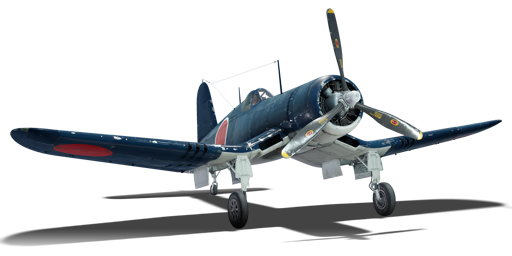



The F4U Corsair was a single-engine fighter that excelled in top-speed performance and fire power. It was a shock to Japanese pilots who were familiar with obsolete aircraft like the F4F Wildcat and F2A Buffalo. As was typical with aerial combat in World War II, some planes faced mechanical problems or damage that forced pilots to crash land. This led to Japanese forces capturing various aircraft, like the P-40 Warhawk, B-17 Flying Fortress, and some Corsairs. Although specific details about the planes are hazy, it is known that Japan did have two Corsairs and fixed one to flying condition. The Japanese conducted various flight tests and were impressed by the materials used in construction and the flight performance.
The F4U-1A (Japan) has been in the game since the start of the Open Beta Test prior to Update 1.27. It is virtually the same as the F4U-1A in the American tech tree, with the exception of the camo used and the lack of suspended armament. Much like the American F4U-1A, the Japanese F4U-1A is an incredibly strong fighter thanks to its high-speed performance, armament, and overall handling. Players should take note of the F4U-1A's limited WEP capability (around 7-8 minutes) as a result of the water injection system used. This version of the Corsair comes armed with six 12.7 mm M2 Browning machine guns and ample ammunition, which is more than enough for its battle rating. Overall, the F4U-1A (Japan) is a strong aircraft, even though it lacks bombs for close air support.
flaps
flaps
flaps
brake
| Belt | Belt filling | Armor penetration (mm) at a distance: | |||||
|---|---|---|---|---|---|---|---|
| 10 m | 100 m | 500 m | 1000 m | 1500 m | 2000 m | ||
| T/Ball/Ball/I/AP-I | 28 | 26 | 18 | 11 | 7 | 4 | |
| AP-I/AP-I/AP-I/T/I | 28 | 26 | 18 | 11 | 7 | 4 | |
| T/AP/AP/AP/AP-I/I | 30 | 27 | 20 | 13 | 9 | 6 | |
| T/T/T/T/T/AP-I | 28 | 26 | 18 | 11 | 7 | 4 | |
| AP/AP-I/AP-I/I/I | 30 | 27 | 20 | 13 | 9 | 6 | |







 2 x (55 / 200 / 295) %
2 x (55 / 200 / 295) % 
 2 x 130 %
2 x 130 % 

Flight performance | |
|---|---|
Survivability |
|---|
Weaponry |
|---|